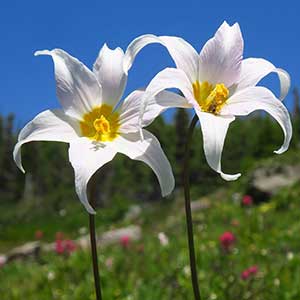Erythronium montanum
Erythronium mesochoreum
avalanche-lily, white avalanche-lily, white glacier lily
midland fawnlily, prairie trout-lily, white fawnlily
narrowly ovoid, 25–60 mm.
ovoid to ± globose, 10–25 mm;
stolons absent; flowering plants reproducing vegetatively by droppers or offshoots.
10–20 cm;
blade green, ovate to broadly lanceolate, base ± abruptly narrowed to petiole, margins wavy.
5–14 cm;
blade green, usually not mottled, elliptic-lanceolate to ovate-lanceolate, conduplicate, glaucous, base and margins sometimes purple-brown, margins even.
12–35 cm.
5–15 cm.
1–3-flowered.
1-flowered.
tepals white to creamy white with bright yellow zone at base, broadly ovate to broadly lanceolate, 25–45 mm, inner wider than outer, auriculate at base, length less than 4 times width;
stamens 12–24 mm;
filaments white, linear, slender, less than 0.8 mm wide;
anthers bright yellow;
style white, 13–25 mm;
stigma with slender, usually recurved lobes 1–5 mm.
tepals spreading at anthesis, white, tinged pink, blue, or lavender abaxially, with yellow adaxial spot at base, lanceolate, 15–30 mm, auricles absent;
stamens 8–15 mm;
filaments yellow, lanceolate;
anthers yellow;
pollen yellow;
style white, 7–10 mm;
stigma lobes recurving, 1–1.5 mm.
oblong, 3–6 cm.
resting on ground at maturity due to reclining peduncle, obovoid, 10–15 mm, apex rounded to faintly apiculate or umbilicate.
= 24.
= 22.
Erythronium montanum
Erythronium mesochoreum
This species occurs in the Coast Ranges of southern British Columbia, and disjunctly to southern Vancouver Island, the Olympic Peninsula, and Cascade Mountains from Mount Rainier National Park in Washington to central Oregon.
(Discussion copyrighted by Flora of North America; reprinted with permission.)
Because stolons are absent in Erythronium mesochoreum, most plants in a population produce flowers; nonflowering plants may sometimes appear after flowering plants have flowered. This species is well adapted to prairie fires. The seeds have elaiosomes, and ants may act as dispersal agents (Great Plains Flora Association 1986). C. C. Deam et al. (1941) reported E. mesochoreum from Indiana, but an examination of the specimens cited, now at IND, showed that these are E. albidum. E. L. Braun (1967) reported that many populations of E. albidum in southwestern Ohio indicate introgression with “the Ozarkean var. mesochoreum���.” However, personal observation by K. R. Robertson of several Ohio populations in flower confirmed that these plants are true E. albidum, although they occur in prairies and have more or less conduplicate leaves.
(Discussion copyrighted by Flora of North America; reprinted with permission.)


